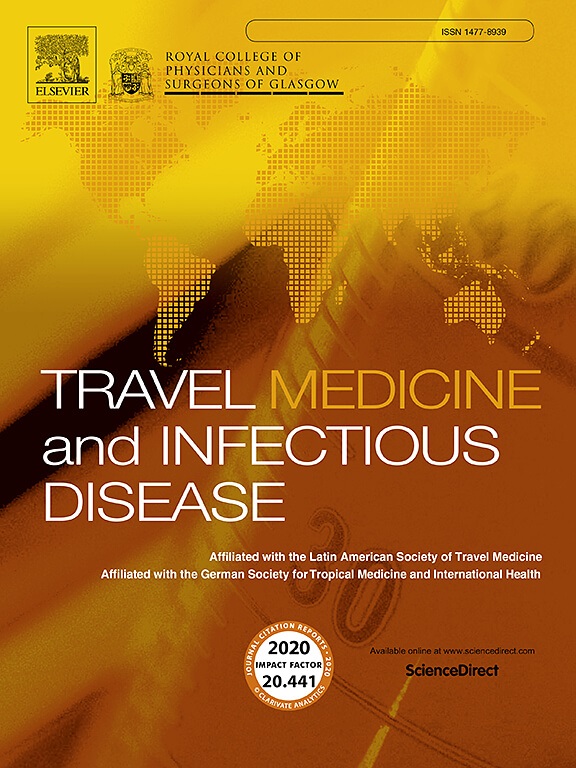恰加斯病诱导肠道微生物代谢应激:能量和核苷酸途径的破坏和抗寄生虫治疗的部分逆转(TRIPOBIOME-2研究)
IF 4.7
3区 医学
Q1 INFECTIOUS DISEASES
引用次数: 0
摘要
恰加斯病(CD)可以改变肠道微生物群组成,尽管其功能影响尚不明确。我们对55名慢性乳糜泻成年患者(其中23名接受苯并硝唑治疗)和17名未感染对照者的粪便样本进行了全基因组宏基因组测序。用humann3标记功能通路,并用ANCOM-BC2评估它们的差异丰度。多样性指标(Chao1/ACE指数和多维尺度)和sPLS-DA模型对群落结构进行了研究。细菌功能的α -和β -多样性组间差异不显著;只有6 - 7%的差异可归因于感染状况或先前的苯并硝唑治疗。然而,慢性CD产生了一个独特的功能特征,其特征是能量生成途径(还原和典型三羧酸循环、脂肪酸β氧化、血红素和2-甲基柠檬酸代谢)的消耗和嘌呤和嘧啶生物合成途径的适度富集。这些变化可能意味着微生物组适应了缺氧、营养缺乏和与克氏锥虫的代谢竞争。与未治疗的患者和对照组相比,苯并硝唑治疗个体表现出部分代谢恢复,即核苷酸和碳水化合物降解途径上调,(5Z)-十二烯酸合成增强,对还原性三羧酸循环的依赖减少,表明微生物生长恢复,短链脂肪酸潜力提高。总的来说,我们的研究结果似乎描绘了慢性乳糜泻中资源有限、代谢紧张的肠道生态系统,其功能失衡可以通过抗寄生虫治疗部分逆转。受影响的途径,特别是那些控制能量和核苷酸代谢的途径,可以用作疾病监测和治疗反应的候选替代标记物,也可以作为微生物群导向的辅助策略的靶标。本文章由计算机程序翻译,如有差异,请以英文原文为准。
Chagas disease induces gut microbial metabolic stress: Disruption of energy and nucleotide pathways and partial reversal by antiparasitic therapy (TRIPOBIOME-2 study)
Chagas disease (CD) can alter gut microbiota composition, although its functional impact is poorly defined. We conducted whole-genome metagenomic sequencing of stool samples from 55 adults with chronic CD (23 treated with benznidazole) and 17 non-infected controls. Functional pathways were annotated with HUMAnN 3, and their differential abundance was assessed using ANCOM-BC2. Diversity metrics (Chao1/ACE indices and multidimensional scaling) and sPLS-DA modelling were used to explore community structure. No significant group differences were observed for alpha- and beta-diversity of bacterial functions; only 6–7 % of variance was attributable to infection status or prior benznidazole therapy. Nevertheless, chronic CD produced a distinctive functional signature marked by depletion of energy-yielding pathways (reductive and canonical tricarboxylic-acid cycles, fatty-acid β-oxidation, haem and 2-methylcitrate metabolism) and modest enrichment of purine and pyrimidine biosynthetic routes. These shifts may imply a microbiome adapting to hypoxia, nutrient scarcity, and metabolic competition with Trypanosoma cruzi. Compared with untreated patients and controls, benznidazole-treated individuals exhibited partial metabolic restoration, namely, up-regulated nucleotide and carbohydrate-degradation pathways, enhanced (5Z)-dodecenoate synthesis, and reduced reliance on the reductive tricarboxylic acid cycle, suggesting renewed microbial growth and improved short-chain-fatty-acid potential. Collectively, our results seem to portray a resource-limited, metabolically stressed gut ecosystem in chronic CD whose functional imbalance is partially reversible with antiparasitic therapy. The affected pathways, particularly those governing energy and nucleotide metabolism, could be used as candidate surrogate markers for disease monitoring and therapeutic response and as targets for microbiota-directed adjuvant strategies.
求助全文
通过发布文献求助,成功后即可免费获取论文全文。
去求助
来源期刊

Travel Medicine and Infectious Disease
PUBLIC, ENVIRONMENTAL & OCCUPATIONAL HEALTH-INFECTIOUS DISEASES
CiteScore
19.40
自引率
1.70%
发文量
211
审稿时长
49 days
期刊介绍:
Travel Medicine and Infectious Disease
Publication Scope:
Publishes original papers, reviews, and consensus papers
Primary theme: infectious disease in the context of travel medicine
Focus Areas:
Epidemiology and surveillance of travel-related illness
Prevention and treatment of travel-associated infections
Malaria prevention and treatment
Travellers' diarrhoea
Infections associated with mass gatherings
Migration-related infections
Vaccines and vaccine-preventable disease
Global policy/regulations for disease prevention and control
Practical clinical issues for travel and tropical medicine practitioners
Coverage:
Addresses areas of controversy and debate in travel medicine
Aims to inform guidelines and policy pertinent to travel medicine and the prevention of infectious disease
Publication Features:
Offers a fast peer-review process
Provides early online publication of accepted manuscripts
Aims to publish cutting-edge papers
 求助内容:
求助内容: 应助结果提醒方式:
应助结果提醒方式:


